The Lake Renegade, Universally at Home
I have said it many times before. I just have a weakness for things and machines that breathe utility, be it a paper clip, a Landrover or an aircraft. Great sky bound examples of the ‘form follows function’ philosophy are the Pilatus PC-6 Porter, the De-Havilland DHC-2 Beaver and DHC-6 Twin-Otter, The 180 and 185 from Cessna and the Helio Courier. All of them are aircraft found in the most remote regions of the world where they are used as workhorses on a variety of missions. Unless extensively modified however all these aircraft rely on some kind of firm runway for take-offs and landings. In today’s market there is one marked exception, the Renegade family of aircraft from Lake.
History
Lake
Aircraft with bases in Laconia New Hampshire, Kissimmee Florida and Stanford
Maine, is currently the world’s only manufacturer of certified single engine
flying boats. Although largely unknown by the public, the people at Lake
Aircraft have been building flying boats for over half a century. It all began
in 1946 when David B. Thurston and Herbert P Lindbad founded the Colonial
Aircraft Corporation. 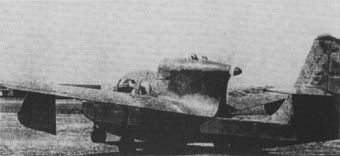 Previously the two
talented engineers had been working for the Grumman Aircraft Company on the
successful Grumman Goose and Widgeon amphibian twins. They also worked on a
lesser-known aircraft, the G-65 tadpole, that flew for the first time in 1944.
The Tadpole was a single engine two-seater flying boat that was geared towards
the private and business market. Before proving it’s self to the top executives
at Grumman the Tadpole program got scrapped, much to the dismay of Thurston and Herbert. They were both a firm
believer of a marker for such an aircraft and driven by this belief they left
Grumman and set up shop for them selves.
Previously the two
talented engineers had been working for the Grumman Aircraft Company on the
successful Grumman Goose and Widgeon amphibian twins. They also worked on a
lesser-known aircraft, the G-65 tadpole, that flew for the first time in 1944.
The Tadpole was a single engine two-seater flying boat that was geared towards
the private and business market. Before proving it’s self to the top executives
at Grumman the Tadpole program got scrapped, much to the dismay of Thurston and Herbert. They were both a firm
believer of a marker for such an aircraft and driven by this belief they left
Grumman and set up shop for them selves.
Their
first aircraft was the three-seater Colonial Skimmer. This aircraft with a now
characteristic pylon mounted engine on top of the fuselage, first flew in the
summer of 1948. Colonial eventually built 42 Skimmers of which 18 were Skimmer
two’s which had four seats.
Because of slow sales, Colonial had to close their doors in 1959, but haunted by his dream Herbert Lindbad soon after founded a new company under the name Lake Aircraft Corporation.
Lindbad almost redesigned the Skimmer from the ground up, before re-introducing it as the LA-4 in 1959. Three years later, Lake was bought by Consolidated Aeronautics Inc. who split Lake up in two divisions. On one side was Aerofab Inc, that was to built the aircraft in Stanford, Maine and on the other side was the Lake Aircraft Division that was to take care of the sale and service of the aircraft.
In 1979, Armand Rivard bought both divisions and has been building Lakes of various shapes and sizes ever since.
Models
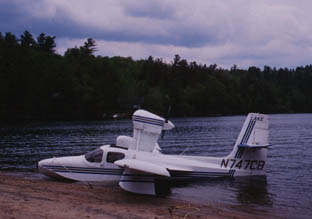 As said, Lake
started building the LA-4 back in the 60’s. This was a four-seater aircraft
powered by a 180 HP pylon mounted engine. A decent performer on land and in the
air, the LA-4 was somewhat of a disappointment on the water. When operated off water, the LA-4 was
downgraded to a two seat aircraft. The 180 ponies on the roof just could not
lift anything more then that.
As said, Lake
started building the LA-4 back in the 60’s. This was a four-seater aircraft
powered by a 180 HP pylon mounted engine. A decent performer on land and in the
air, the LA-4 was somewhat of a disappointment on the water. When operated off water, the LA-4 was
downgraded to a two seat aircraft. The 180 ponies on the roof just could not
lift anything more then that.
This prompted Lake to install a 200 HP Lycoming instead, turning the LA-4 into the LA-4-200. From this moment the designation was complemented by the name ‘Buccaneer’. During the early eighties the buccaneer was replaced by the LA-200EP (Extra Power). To claim the extra power the EP received a lengthened propeller shaft and a much-improved cowling, resulting in less drag and more thrust. Some EP’s also received a reversible propeller, greatly improving the slow speed handling on water. These now rare aircraft, received the designation LA-200EPR.
In 1982
Lake took a huge step forward with the introduction of the greatly improved
LA-250 Renegade. 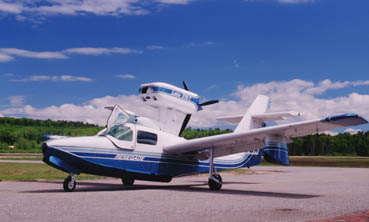 The Renegade still
bares the family features of the earlier models but is enlarged to accommodate
6 adults quite comfortably. Up in the pylon the Four Cylinder IO-360 made way
for a six Cylinder IO-540 that produces 250 HP. Besides a jump in useful load,
the Renegade offers much improved water handling, through it’s substantially
longer deep V hull. To feed the thirstier Lycoming, the fuel capacity was
increased to a maximum of 90 gallons. Besides these obvious modifications, many
more detail improvements found their way into the new Renegade.
The Renegade still
bares the family features of the earlier models but is enlarged to accommodate
6 adults quite comfortably. Up in the pylon the Four Cylinder IO-360 made way
for a six Cylinder IO-540 that produces 250 HP. Besides a jump in useful load,
the Renegade offers much improved water handling, through it’s substantially
longer deep V hull. To feed the thirstier Lycoming, the fuel capacity was
increased to a maximum of 90 gallons. Besides these obvious modifications, many
more detail improvements found their way into the new Renegade.
In 1987 a Turbo charged variant of the Renegade, the LA-270T Turbo Renegade was introduced to accommodate altitude hungry aviators.
Although the Renegade is universally accepted as a very capable aircraft, Lake hasn’t been sitting still in recent years. The Renegades are slowly being replaced on the production line by Seafuries. As the name implies, the Seafury is especially geared to salt water operations. The biggest difference between it and the Renegade is the generous use of space age ceramic corrosion proofing techniques to protect the Seafury’s construction in the harshest of environments. The Seafury comes in both the 250 normally aspirated and the 270 HP turbocharged versions.
Military brethren

 Last but not least
there are the two military versions of the Renegade family. The most potent is
the Seawolfe. Blessed with a higher gross weight, a 290 HP turbocharged engine,
and six standard Nato hard points under the wing, the Seawolf can be adapted
for a multitude of missions. The most frequent use of this
Last but not least
there are the two military versions of the Renegade family. The most potent is
the Seawolfe. Blessed with a higher gross weight, a 290 HP turbocharged engine,
and six standard Nato hard points under the wing, the Seawolf can be adapted
for a multitude of missions. The most frequent use of this wolf in sheep’s
clothes, is that of Marine Patrol and Search and Rescue With it’s capacity to
carry rockets, guns, night vision equipment, radar and infra red and visible
spectrum camera’s however, the sky is the limit.
wolf in sheep’s
clothes, is that of Marine Patrol and Search and Rescue With it’s capacity to
carry rockets, guns, night vision equipment, radar and infra red and visible
spectrum camera’s however, the sky is the limit.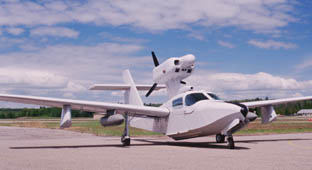
For those who want the higher gross weight but don’t need all the bells and whistles of the Seawolfe, there is the Ranger. This is basically a beefed up Seafury with a 290 HP engine.
Laconia
On one
beautiful late summer day, I drive my rental car into Laconia, New Hampshire. 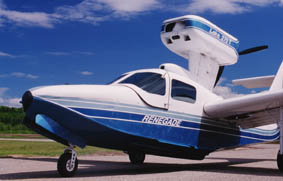 On a corner, next
to the local high school that looks like the set of a Hollywood saga on
small-town USA, I drop a quarter in a payphone and call Bruce Rivard, son of
Armand and Vice-President of the Lake Aircraft Company. He gives me directions
to the airport and will meet me there in 20 minutes. Arriving at the airport,
the Lake Aircraft hangar would be a rather obscure building was it not for a
ring of ‘experienced’ Buccaneers and Renegades that surround it. It’s an other
10 minutes before Bruce arrives in a just as ‘mature’ Volkswagen Rabbit,
sporting shorts a t-shirt and loafers. Like the aircraft they build, the
Revards are practical people. He greets me with a warm “Welcome to the flying
boat capital of the world” and a firm handshake. We spend about fifteen minutes
walking around the premises and chatting about Lake’s history, the aircraft
they build now and what the future holds for this last outpost of ‘wet feet’
aviation. The aircraft outside, that all look the part of hard working and hard
playing machines, are contrasted by a brand new Seawolf and a totally restored
EP inside that both look and smell brand new. Bruce knows that these two
beautiful aircraft will look just as ‘used’ as the ones outside before the year
is over. “Lake aircraft are built for a serious pounding and that is exactly
what the new owners of these aircraft will do with them. They are built for the
rough and soon will look the part.” Bruce says. He doesn’t mind though, because
a great deal of his business is the maintenance and repair of used Lakes form
all over the country and in fact the world. Owners love coming back to the
birthplace of their aircraft as well. Because the technicians have been around
forever, and all necessary parts are only footsteps from the work floor, the
cost is kept down and the turn around times for repairs and inspections are
minimised.
On a corner, next
to the local high school that looks like the set of a Hollywood saga on
small-town USA, I drop a quarter in a payphone and call Bruce Rivard, son of
Armand and Vice-President of the Lake Aircraft Company. He gives me directions
to the airport and will meet me there in 20 minutes. Arriving at the airport,
the Lake Aircraft hangar would be a rather obscure building was it not for a
ring of ‘experienced’ Buccaneers and Renegades that surround it. It’s an other
10 minutes before Bruce arrives in a just as ‘mature’ Volkswagen Rabbit,
sporting shorts a t-shirt and loafers. Like the aircraft they build, the
Revards are practical people. He greets me with a warm “Welcome to the flying
boat capital of the world” and a firm handshake. We spend about fifteen minutes
walking around the premises and chatting about Lake’s history, the aircraft
they build now and what the future holds for this last outpost of ‘wet feet’
aviation. The aircraft outside, that all look the part of hard working and hard
playing machines, are contrasted by a brand new Seawolf and a totally restored
EP inside that both look and smell brand new. Bruce knows that these two
beautiful aircraft will look just as ‘used’ as the ones outside before the year
is over. “Lake aircraft are built for a serious pounding and that is exactly
what the new owners of these aircraft will do with them. They are built for the
rough and soon will look the part.” Bruce says. He doesn’t mind though, because
a great deal of his business is the maintenance and repair of used Lakes form
all over the country and in fact the world. Owners love coming back to the
birthplace of their aircraft as well. Because the technicians have been around
forever, and all necessary parts are only footsteps from the work floor, the
cost is kept down and the turn around times for repairs and inspections are
minimised.
 The impressive
Seawolfe is going through its last checks before being delivered to an
anonymous client in the Far East. Anonymous? My querying look is answered with
a smile from Bruce and a cheerful, “Don’t worry, we only sell Seawolfes to the
‘good guys’. The bad guys only get the Ranger, that can’t take rockets and
guns.”
The impressive
Seawolfe is going through its last checks before being delivered to an
anonymous client in the Far East. Anonymous? My querying look is answered with
a smile from Bruce and a cheerful, “Don’t worry, we only sell Seawolfes to the
‘good guys’. The bad guys only get the Ranger, that can’t take rockets and
guns.”
To my
question; why they stopped building the four seater, Bruce answers; “ It costs
about as much to build a Renegade as it does a Buccaneer and for the same money
you get much more aircraft. There just was no demand for the Buccaneer
anymore.” Lake is now seeing the same thing happening with the Seafury. Despite
the $40,000 higher price tag for all the fancy corrosion proofing, most people
now want to get a Seafury instead of a Renegade.
Out to
fly and float
To the
side of the hangar, towards the runway, awaits my magic carpet for the
afternoon. N8435A is a customer’s LA-270T that the Rivards lease back for the
occasional demonstration and training flight. With around 600 hours total time
she is an average example of a turbocharged Renegade. Her exterior shows a few
scuffmarks from overenthusiastic encounters with docks and ramps but in all she
looks pretty clean.  It is soon
apparent that the aircraft is pretty low slung and that eye level for the pilot
is about waist high for an average standing person. This makes for an
interesting perspective for the novice Lake driver, both on land and on water.
Everything on the aircraft breathes functionality. No frills bells and whistles
can be found anywhere, just straight utility. Ingress to the aircraft’s
interior is made quite easy by the generous folding canopies up front and the
huge ‘cargo door’ to the right hand side. Opening both the right hand canopy
and door reveals a huge entry for long and bulky items such as stretchers golf
bags or ski’s. Behind the pilot seats, a 10 feet flat floor area can be
revealed by simply removing the passenger seats.
It is soon
apparent that the aircraft is pretty low slung and that eye level for the pilot
is about waist high for an average standing person. This makes for an
interesting perspective for the novice Lake driver, both on land and on water.
Everything on the aircraft breathes functionality. No frills bells and whistles
can be found anywhere, just straight utility. Ingress to the aircraft’s
interior is made quite easy by the generous folding canopies up front and the
huge ‘cargo door’ to the right hand side. Opening both the right hand canopy
and door reveals a huge entry for long and bulky items such as stretchers golf
bags or ski’s. Behind the pilot seats, a 10 feet flat floor area can be
revealed by simply removing the passenger seats.
The front row passengers have ample room and a grand unobstructed view through the large windows. That is contrasted by the ‘cheap seats’ in the back of the cabin that lack legroom and windows. Although there is a side window modification available for the Renegade, Bruce admits that most people use the aft seating area for extra baggage space and therefore don’t bother with it.
 Just as we are
completing the pre-flight of three five Alpha, a minibus stops and a handsome
young man and pretty girl get out. It is Bruce’s son Ian and one of his
classmates he seems eager to impress. A few moments later the two teens clime
over the transom into the back seats, while I take a seat next to Bruce up
front. The cargo door is closed, but we keep one of the canopies wide open.
Since the aft facing propeller does not generate any slipstream in the cockpit
we can enjoy the fresh air while taxiing to the active for take off. The nose
gear is free turning so we steer on the ground by occasionally tapping the
brakes. This is easy enough in the calm afternoon air, but can be a challenge
when facing a stiff crosswind. Thanks to the aft mounted wing, and the sloped
nose the view from the pilot seat is absolutely unique. It is therefore not
surprising that Lake’s are slowly starting to dominate the market of marine and
law enforcement observation aircraft. As an aerial photographer, I can
certainly appreciate that side of the Lake’s inner beauty.
Just as we are
completing the pre-flight of three five Alpha, a minibus stops and a handsome
young man and pretty girl get out. It is Bruce’s son Ian and one of his
classmates he seems eager to impress. A few moments later the two teens clime
over the transom into the back seats, while I take a seat next to Bruce up
front. The cargo door is closed, but we keep one of the canopies wide open.
Since the aft facing propeller does not generate any slipstream in the cockpit
we can enjoy the fresh air while taxiing to the active for take off. The nose
gear is free turning so we steer on the ground by occasionally tapping the
brakes. This is easy enough in the calm afternoon air, but can be a challenge
when facing a stiff crosswind. Thanks to the aft mounted wing, and the sloped
nose the view from the pilot seat is absolutely unique. It is therefore not
surprising that Lake’s are slowly starting to dominate the market of marine and
law enforcement observation aircraft. As an aerial photographer, I can
certainly appreciate that side of the Lake’s inner beauty.
 For a novice, the
overhead engine controls are a bit of a novelty for small aircraft. Having
flown the De Havilland Twin-Otter however, I feel right at home. After some
last checks and the careful latching of the canopy we are free to push the
throttle all the way forward. The Turbocharged Lycoming is fitted with an
automatic waist gate to control the maximum manifold pressure, so we don’t have
to tweak the throttle until we reduce the power for the climb. Noise is typical
for a light aircraft, but perhaps a little less intrusive in the cockpit
because of the engine’s aft position. The take-off run took no more then 6 or
700 feet and after tucking the wheels into the wings and nose the climb rate
settles on a hefty 1100 feet. Not bad for a 20 feet cabin cruiser… The gears,
like the flaps and elevator trim are hydraulically controlled. Pressure is
generated by an electrical pump and is stabilized by an accumulator. In case of
a failure of the electrical pump, a hand pump is available to charge the
accumulator.
For a novice, the
overhead engine controls are a bit of a novelty for small aircraft. Having
flown the De Havilland Twin-Otter however, I feel right at home. After some
last checks and the careful latching of the canopy we are free to push the
throttle all the way forward. The Turbocharged Lycoming is fitted with an
automatic waist gate to control the maximum manifold pressure, so we don’t have
to tweak the throttle until we reduce the power for the climb. Noise is typical
for a light aircraft, but perhaps a little less intrusive in the cockpit
because of the engine’s aft position. The take-off run took no more then 6 or
700 feet and after tucking the wheels into the wings and nose the climb rate
settles on a hefty 1100 feet. Not bad for a 20 feet cabin cruiser… The gears,
like the flaps and elevator trim are hydraulically controlled. Pressure is
generated by an electrical pump and is stabilized by an accumulator. In case of
a failure of the electrical pump, a hand pump is available to charge the
accumulator.
Once airborne and trimmed for straight and level flight, the flight controls feel firm and surprisingly well coordinated. As expected, the Renegade is not a ballerina, but still surprisingly nimble when coached firmly. In the smooth air above lake Winnipesaukee, the Renegade holds her course admirably when the yoke is released.



As in any
amphibian aircraft, landings are to be well-rehearsed exercises in procedures.
Whereas a wheel up landing on firm ground will do little more to a Lake then
scratch the paint off the keel, a wheel down landing on water could spell
instant disaster. The main gears are easily monitored from the cockpit, while
the nose wheel can be checked in a little mirror mounted to the left hand pontoon.
As experienced as he is, Bruce says the amphibian pilot chant out loud; “Water
landing, gear is up”, while visually checking the gear handle, all three gears,
and last but not least the blue light on the console. Bruce retards the power
to bleed off some speed and selects the flaps to down. This is a ‘no brainer’,
since the flaps have only two positions. Up for flight and down for take-off
and landing. We can now see how much drag the Lake can generate. Even without
the gear down the waters below fill both canopies while the speed is nice and
stabilized. That steep approach can sure come in handy when operating from
small bodies of water in mountainous terrain. Just above the water Bruce pulls
straight to bleed off the speed before touching the wave tops in a level
attitude.  Once in the water
an ungodly noise erupts from metal pounding on rock hard water. This is why
Lakes must be built like a brick (you know what) house. The wild ride only
lasts a few seconds though as the Lake settles trough the waves and continues
leisurely to the shore. We head for a ramp at what use to be Armand Rivard’s
house, a beautiful contemporary wooden building with large decks overlooking
the shore.
Once in the water
an ungodly noise erupts from metal pounding on rock hard water. This is why
Lakes must be built like a brick (you know what) house. The wild ride only
lasts a few seconds though as the Lake settles trough the waves and continues
leisurely to the shore. We head for a ramp at what use to be Armand Rivard’s
house, a beautiful contemporary wooden building with large decks overlooking
the shore.
Before
reaching the ramp, Bruce lowers the gear and when convinced he is over firm
ground he hammers the throttle forward to keep his momentum up the steep ramp.
The roar of the engine brings people from surrounding houses to their decks to
watch the spectacle. To my relief their raised hands are not bald in fists but
are waiving friendly. This kind of tolerance can be an example for tight-butted
Europeans who mow their lawns every Saturday with annoying power mowers, but
frown at every light aircraft that comes overhead.
The girl
is gallantly helped out of the back and continues to walk up the road to her
house on the hill. The smile and the friendly wave back tells me that Ian’s
mission is a success. It’s hard not to be impressed by a ride home and a
drop-off on the lakefront by a Lake Renegade…
 I stay on shore to
make a couple of pictures as Bruce and Ian take to the water for a couple of
low fly by’s and ‘splash and goes’.
I stay on shore to
make a couple of pictures as Bruce and Ian take to the water for a couple of
low fly by’s and ‘splash and goes’.  Ten minutes later
they are back to pick me up and we head trough the air for a small beach around
the corner from Bruce’s waterfront home. His wife Katy and younger son Brandon
are awaiting us with a small speedboat for some more pictures. Without lowering
the gear Bruce runs the Lake op on the beach just like a boat and allows us to
get out without getting our feet wet. After introductions, I take to the water
in the speedboat with Katie and Ian, while Bruce and Brandon get back in the
Renegade. Out on the water Bruce plays with the Renegade as if it is a dragon
fly dashing over the surface. My Gyro Stabilizer is zooming happily and my
motor drive is running hot shooting roll after roll of film in the beautiful
sunset.
Ten minutes later
they are back to pick me up and we head trough the air for a small beach around
the corner from Bruce’s waterfront home. His wife Katy and younger son Brandon
are awaiting us with a small speedboat for some more pictures. Without lowering
the gear Bruce runs the Lake op on the beach just like a boat and allows us to
get out without getting our feet wet. After introductions, I take to the water
in the speedboat with Katie and Ian, while Bruce and Brandon get back in the
Renegade. Out on the water Bruce plays with the Renegade as if it is a dragon
fly dashing over the surface. My Gyro Stabilizer is zooming happily and my
motor drive is running hot shooting roll after roll of film in the beautiful
sunset. 
When the
film is all shot, we return to the Rivard’s family jetty at the bottom of the
garden. Before getting my gear packed and up the stairs, Bruce and Brandon are
back from the airport. 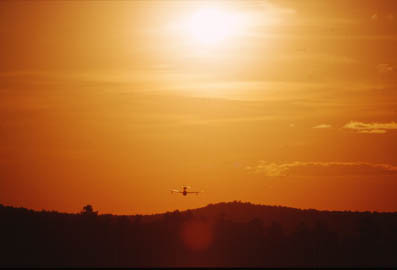
After one
of the most incredible days in my flying career, my luck is still not over.
Armand, who lives in Florida most of the year, is in town and he and Bruce
invite me to dinner at the local hot spot. There the evening fades with good
food and great conversation. What did we talk about? What do you think. Lake
aircraft and the incredible adventures they open up. 
The Lake Renegade is in a league of it’s own and therefore hard to measure against other aircraft. What surprised me most of all was that as a flying machine it hold it’s own in the company of landlocked machines such as Cessna’s 206 and Piper Cherokee Six.



As a boat, well having seen the Renegade in action at the hands of a master, leads me to believe that Bayliners are toys for kids. Combining the two worlds in just one machine makes it simply irresistible to adventure seeking aeronautical buffs like me. The only thing missing for me to get a Renegade of my own is a bank account to mach my desire. One day though, one day…
Simon Broek